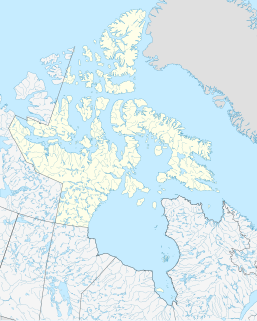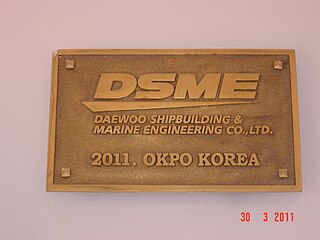Related Research Articles

The Northwest Passage (NWP) is the sea route between the Atlantic and Pacific oceans through the Arctic Ocean, along the northern coast of North America via waterways through the Canadian Arctic Archipelago. The eastern route along the Arctic coasts of Norway and Siberia is accordingly called the Northeast Passage (NEP). The various islands of the archipelago are separated from one another and from Mainland Canada by a series of Arctic waterways collectively known as the Northwest Passages or Northwestern Passages.

Pond Inlet is a small, predominantly Inuit community in the Qikiqtaaluk Region of Nunavut, Canada, located on northern Baffin Island. To the Inuit the name of the place "is and always has been Mittimatalik." The Scottish explorer Sir John Ross had named an arm of the sea that separates Bylot Island from Baffin Island as Pond's Bay, and the hamlet now shares that name. On August 29, 1921, the Hudson's Bay Company opened its trading post near the Inuit camp and named it Pond Inlet, marking the expansion of its trading empire into the High Arctic.

Bylot Island lies off the northern end of Baffin Island in Nunavut Territory, Canada. Eclipse Sound to the southeast and Navy Board Inlet to the southwest separate it from Baffin Island. Parry Channel lies to its northwest. At 11,067 km2 (4,273 sq mi) it is ranked 71st largest island in the world and Canada's 17th largest island. The island measures 180 km (110 mi) east to west and 110 km (68 mi) north to south and is one of the largest uninhabited islands in the world. While there are no permanent settlements on this Canadian Arctic island, Inuit from Pond Inlet and elsewhere regularly travel to Bylot Island. An Inuit seasonal hunting camp is located southwest of Cape Graham Moore.

A bulk carrier,bulker is a merchant ship specially designed to transport unpackaged bulk cargo, such as grains, coal, ore, steel coils and cement, in its cargo holds. Since the first specialized bulk carrier was built in 1852, economic forces have led to continued development of these ships, resulting in increased size and sophistication. Today's bulk carriers are specially designed to maximize capacity, safety, efficiency, and durability.

Fednav is a privately owned group of Canadian companies, divisions, and subsidiaries in the maritime transport industry. Primarily involved in transporting over 30 million tonnes of bulk cargo and break bulk cargo worldwide, the company is also involved in vessel servicing and cargo handling.
Mary River is located on Baffin Island in the Qikiqtaaluk Region of Nunavut, about 936 km (582 mi) northwest of the capital, Iqaluit, and about 176 km (109 mi) southwest of Pond Inlet Inuktitut: Mittimatalik, lit. 'the place where the landing place is' The Inuit, name for the Mary River mountain is Nuluyait, meaning buttocks. There is a 4,000 year history in the area. For hundreds of years the semi-nomadic Inuit from the region that includes the hamlets of Pond Inlet and Igloomik, met at Mary River during the summer hunting caribou. By 2011, the population of the region was about 5,400 people, many of whom continued the traditional hunting and fishing lifestyle living off the land.
Milne Inlet is a small, shallow arm of Eclipse Sound which, along with Navy Board Inlet, separates Bylot Island from Baffin Island in Nunavut's Qikiqtaaluk Region. Milne Inlet flows in a southerly direction from Navy Board Inlet at the confluence of Eclipse Sound. Milne Inlet is shallow and has high tides and strong winds. It only has 90 days where it is ice-free—from August to October. The hamlet of Mittimatalik —Pond Inlet which is 92% Inuit, is the gateway to many tourist attractions in the region, and is 80 km from Milne Inlet. The region is part of the Arctic Cordillera, with one of Canada's most inhospitable climates—with long, dark winters and temperatures averaging −35 °C (−31 °F).
Steensby Inlet is a waterway in Nunavut's Qikiqtaaluk Region. It extends northerly from Foxe Basin into central Baffin Island. There are several unnamed islands within the inlet, and Koch Island lies outside of it. The Steensby Inlet Ice Stream arose after the deglaciation of Foxe Basin.

The Mary River Mine is an open pit iron ore mine on Inuit Owned Land (IOL) operated by the Baffinland Iron Mines Corporation (BIMC), in the Mary River area of Qikiqtaaluk Region, Baffin Island, Nunavut, in the Canadian Arctic Archipelago. As of 2021, Mary River mine operation consists of an open-pit mine, two work camps for hundreds of workers, a tote road—from the Mary River site to Milne Inlet—and a port infrastructure at Milne Inlet. According to a 4-year study published in 2008, the Mary River Mine, with its four massive iron ore deposits of 65-70% pure iron ore was "one of the most promising undeveloped iron deposits on the planet". It was not until technological advances were in place in 2010, and the market for iron ore had dramatically increased that sizable financial backing for the high cost of development in a remote region known for its inhospitable climate, was available. The mine began operations in 2014, and the first shipment to Europe arrived in 2015. Baffinland is currently planning on expanding the mine. In February 2021, a group of Inuit hunters blockaded access to the mine for a week to protest the expansion.

Chinamax is a standard of ship measurements that allow conforming ships to use various harbours when fully laden, the maximum size of such a ship being 24 m (79 ft) draft, 65 m (213 ft) beam and 360 m (1,180 ft) length overall. An example of ships of this size is the Valemax bulk carriers.

MS Ore Brasil, previously known as Vale Brasil, is a very large ore carrier owned by the Brazilian mining company Vale. She is the first of seven 400,000-ton very large ore carriers (VLOC) ordered by Vale from Daewoo Shipbuilding & Marine Engineering in South Korea and twelve from Jiangsu Rongsheng Heavy Industries in China, which are designed to carry iron ore from Brazil to Asia along the Cape route around South Africa. While close to the specifications of Chinamax, these ships are generally referred to as Valemax vessels by Vale. They are the largest bulk carriers ever built.
The Isua Iron Mine is a proposed mine in Greenland.

Algoma Equinox is a lake freighter and lead ship of her class built for Algoma Central, a Canadian shipping company. The vessel was built to a new design by Nantong Mingde Heavy Industries at their shipyard in Tongzhou, China in 2013. The ship entered service in December 2013, operating in the Great Lakes and Saint Lawrence Seaway.
MS Nordic Orion is a Danish bulk carrier registered in Panama City. A coal and ore carrier, Nordic Orion has a capacity of 75,603 tonnes deadweight (DWT). It was built in 2011 by Oshima Shipbuilding. Nordic Orion has an ice-strengthened hull, and it is notable for being the first large sea freighter to transit the Arctic Northwest Passage. It is owned and operated by Nordic Bulk Carriers.

CSL Tecumseh is a self-unloading Panamax bulk carrier that entered service with Canada Steamship Lines (CSL) in 2013. The ship is currently registered in Nassau, Bahamas.
Nunavik is an icebreaking bulk carrier owned and operated by the Canadian shipping company Fednav. She is used to transport copper and nickel from the Nunavik Nickel Project, making 7–8 round trips per year.
Federal Tiber is a bulk carrier. It was the first freighter to ship iron ore from the Baffinland mines, out of Milne Inlet, on its way to Nordenham, Germany, on August 8, 2015. CBC North reported it carried 53,624 tonnes of ore.
Nordic Bulk Carriers is a Danish shipping firm that operates large bulk carriers in northern waters. The firm was founded in 2009 by Christian Bonfils and Mads Boye Petersen. Bonfils resigned in January 2015, and the firm was acquired by Pangaea Logistics Solutions.
MV Stellar Daisy was a South Korean-owned very large ore carrier (VLOC) that sank on March 31, 2017 in the South Atlantic off the coast of Uruguay while on a voyage from Brazil to China. She was the largest ship, by a factor of over three on gross tonnage, to be lost at sea.
References
- 1 2 Holly Birkett (2015-08-31). "First panamax carries iron ore from Canada's Arctic to Europe". Splash247. Archived from the original on 2015-12-11. Retrieved 2015-12-10.
The 1A ice-classed ship loaded the cargo on August 12 at Milne Port, on the island’s north shore, and arrived at Gijon in Spain on August 23.
- 1 2 "Pangaea bulker in new ice voyage 'first'". Lloyd's list. 2015-09-01. Archived from the original on 2015-11-01. Retrieved 2015-12-10.
A PANGAEA Logistics Solutions panamax bulk carrier has completed a pioneering voyage from Canada’s Baffin Island to Europe through the Arctic ice.The 77,000 dwt Nordic Odin, a joint venture 1A ice-class bulker delivered earlier this year and operated by Pangaea subsidiary Nordic Bulk Carriers.
- ↑ "Bulker With A Bite". Archived from the original on 2015-12-11. Retrieved 2015-12-10.
This will also be the case for Nordic Odin following her completion of a short-term charter handling coal from Russia to Japan. The four ships are expected to make Nordic Bulk Carriers the world’s leading operator of 1A ice classed dry bulk tonnage.
- ↑ "Nordic Olympic & Nordic Odin join Unicom's fleet". Unicom. 2015-02-13. Archived from the original on 2015-12-11. Retrieved 2015-12-10.
Swiftly following her sister vessel, Nordic Odin, delivered on the 13th February, will also be bunkering at Busan, South Korea and will then be heading to the Vanino, Russia for the loading of coal. From there she will travel to Kimitsu and Nagoya, Japan, for discharging.
- ↑ "First Panamax lot of ore shipped from Canadian Arctic to Europe". International Seaborne Market. 2015-09-03. Archived from the original on 2015-12-11. Retrieved 2015-12-10.
The bulk carrier Nordic Odin, operated by Nordic Bulk Carriers A/S, has completed the first trip on iron ore transportation from Baffin Island (Canada) to Europe via the arctic ice, morvesti.ru reports.
- ↑ "Pangaea Logistics Solutions' MV Nordic Odin Completes Pioneering Voyage from Baffin Island to Europe". Yahoo News. 2015-08-31. Retrieved 2015-12-11.